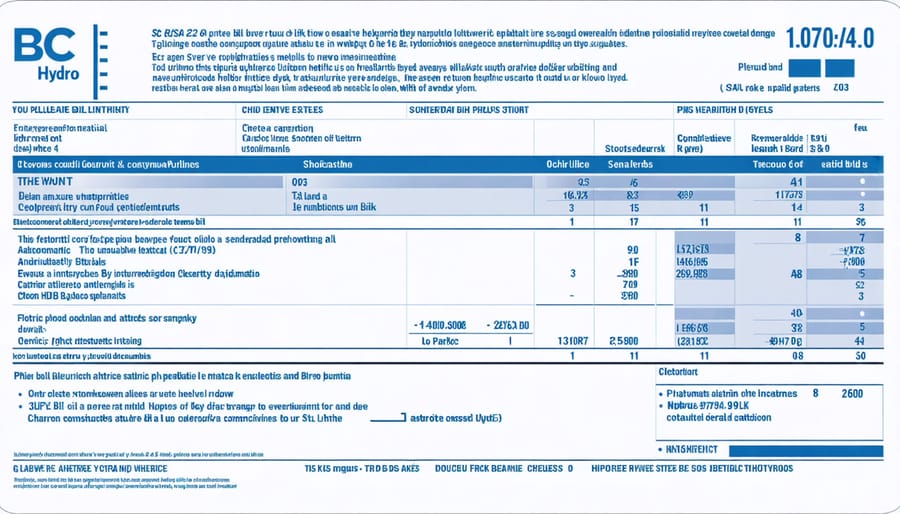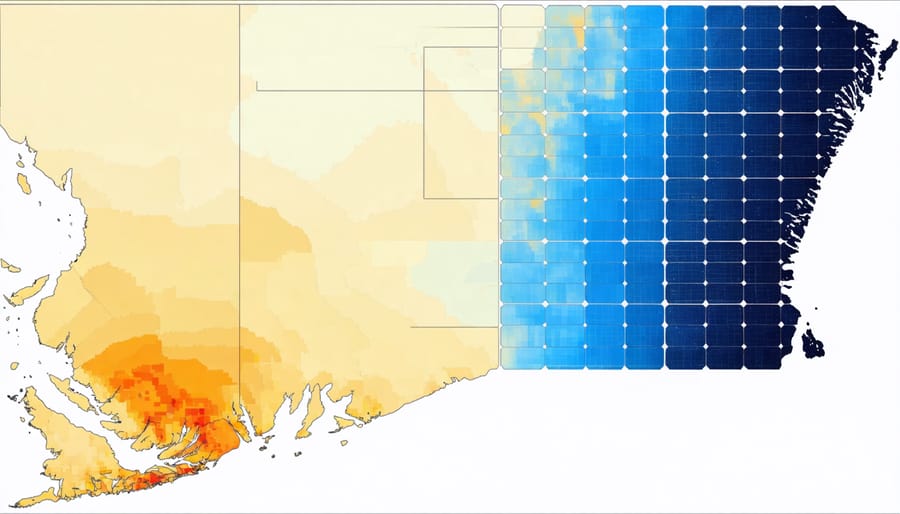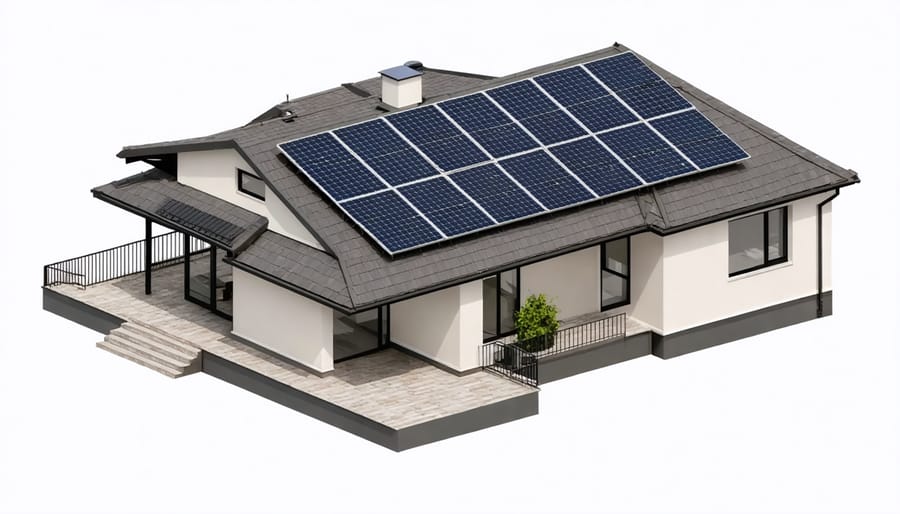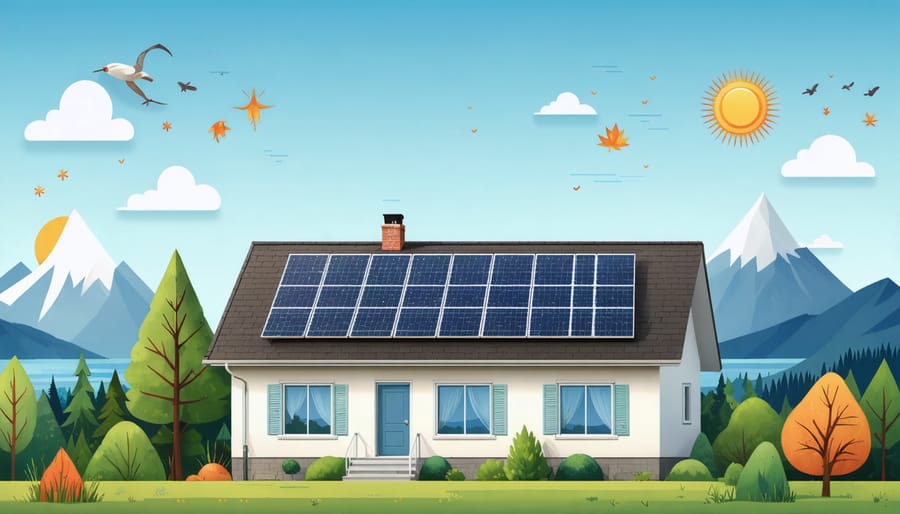Sizing your solar panel system starts with a precise calculation of your home’s annual electricity consumption in kilowatt-hours (kWh) – pull out your BC Hydro bills from the past 12 months for accurate figures. British Columbia’s unique climate patterns, from sunny Okanagan summers to overcast coastal winters, significantly impact your system’s potential output and required size. A properly sized system balances your energy needs with available roof space, accounting for BC’s average 4.3 peak sun hours per day and local building codes.
The right-sized solar installation can offset 50-100% of your electricity bills while qualifying for clean energy incentives and net metering programs. Most BC homes require between 6-12 kW systems, though your specific needs depend on factors like roof orientation, shading, and energy consumption patterns. Working with a certified local installer ensures your system meets municipal requirements while maximizing performance in our region’s distinct weather conditions.
Our growing community of solar adopters in British Columbia demonstrates that thoughtful system sizing leads to decades of reliable clean energy production and significant cost savings. The initial investment in proper sizing pays dividends through optimal energy generation and reduced utility bills.
Calculate Your Home’s Energy Needs
Analyzing Your BC Hydro Bills
Understanding your BC Hydro bills is crucial for correctly sizing your solar panel system. Your electricity bills provide valuable insights into your household energy consumption patterns throughout the year.
Start by collecting your BC Hydro bills from the past 12 months. Look for your monthly kilowatt-hour (kWh) usage, which is clearly displayed on each bill. Pay special attention to seasonal variations – British Columbia homes typically use more electricity during winter months for heating and lighting.
Your bill is divided into two rate tiers: Step 1 and Step 2. The threshold between these tiers (currently at 1,376 kWh bi-monthly for residential customers) can help you understand your baseline consumption. If you’re frequently reaching Step 2 rates, there’s greater potential for solar savings.
To identify peak usage periods, review your consumption history on BC Hydro’s online portal. Look for patterns in your daily and monthly usage. Note when your consumption spikes – is it during summer afternoons when air conditioning is running, or winter evenings when everyone’s home?
Keep track of any planned changes that might affect your future electricity usage, such as switching to an electric vehicle or installing a heat pump. These factors will influence the size of solar system you’ll need.

Future-Proofing Your Energy Needs
When sizing your solar panel system, it’s crucial to think beyond your current energy needs and plan for future changes. Many BC homeowners find themselves needing more power a few years after installation, especially with the rising popularity of electric vehicles and home renovations.
Consider adding a 20-30% buffer to your calculated system size to accommodate future needs. For example, if you’re planning to purchase an electric vehicle, factor in approximately 3,000-4,000 kWh of additional annual consumption. A typical EV in BC uses about 8-10 kWh per day for average commuting distances.
Home additions like a new hot tub, heat pump, or expanded living space can significantly increase your energy requirements. A basement suite conversion typically adds 20-30% to your home’s electricity usage, while a heat pump installation might require an additional 2,500-3,500 kWh annually.
Smart planning also means considering your roof space strategically. Leave room for potential panel additions if possible, and ensure your initial inverter size can handle future expansions. Many BC homeowners are now installing EV-ready systems, even if they don’t own an electric vehicle yet.
Remember that upgrading your system later often costs more than installing a larger system initially. By anticipating future needs today, you’ll save money and avoid potential complications down the road. Work with your solar installer to create a flexible system design that can grow with your needs.
BC’s Solar Potential
Regional Sun Hours
British Columbia’s diverse geography creates significant variations in solar irradiance across BC, making it crucial to understand your local sun hours when sizing a solar panel system. The Okanagan Valley, for instance, receives approximately 2,000 hours of sunshine annually, making it one of BC’s most solar-friendly regions. Vancouver Island and the Lower Mainland typically experience about 1,600 to 1,800 sun hours per year, while northern regions like Prince George see around 1,400 hours.
These regional differences directly impact your system’s potential energy production. For example, a 5kW system in Kelowna might generate more electricity than the same system in Victoria due to longer sun exposure hours. However, don’t let lower sun hours discourage you – even coastal areas with more cloudy days can still benefit significantly from solar power, as modern panels can effectively capture diffused sunlight.
To maximize your system’s efficiency, consider seasonal variations in your area. Summer months naturally offer more sunlight hours, with some BC regions enjoying up to 16 hours of daylight. Winter months see considerably less sunshine, typically 8 hours or fewer, which should factor into your sizing calculations.

Seasonal Variations
British Columbia’s distinct seasonal patterns significantly impact solar panel performance throughout the year. During summer months (June to August), BC experiences long daylight hours, with some regions receiving up to 16 hours of sunlight daily, making it ideal for solar energy production. However, winter months (November to February) see considerably shorter days and reduced solar intensity.
To account for these variations, size your system based on annual average production rather than peak summer output. A good rule of thumb for BC homeowners is to add 20-25% more capacity than your calculated needs to compensate for winter’s reduced production. This approach ensures adequate power generation year-round.
Consider local weather patterns as well. Coastal areas like Vancouver and Victoria experience more cloudy days and rain, while interior regions like Kelowna enjoy more sunny days annually. Snow coverage in winter can actually help by reflecting light onto panels, but you’ll need to factor in occasional snow removal from panels.
Monitor your energy usage patterns across seasons. Many BC households use more electricity in winter for heating and lighting, exactly when solar production is lowest. Understanding these seasonal demands helps determine the optimal system size to meet your year-round energy needs.
Determining Panel Count and System Size
Panel Efficiency Factors
When sizing your solar panel system, it’s crucial to understand that rated power output differs from real-world performance. While panels might be rated at specific wattages under ideal conditions, several factors affect their actual efficiency in British Columbia’s unique climate.
Temperature plays a significant role, with panels typically performing better in cooler conditions. Fortunately, BC’s moderate climate often works in our favor, allowing for optimal panel efficiency calculations. However, factors like shade from nearby trees or buildings, dust accumulation, and snow coverage during winter months can reduce performance by 10-25%.
Local solar installer Sarah Thompson notes, “We typically recommend adding a 20% buffer to account for these efficiency factors when sizing systems in BC. This ensures homeowners aren’t disappointed with their system’s output during less-than-ideal conditions.”
Modern solar panels generally operate at 15-20% efficiency, converting that percentage of available sunlight into usable electricity. Premium panels can reach efficiency ratings of up to 23%, though they come at a higher cost. Consider these real-world efficiency factors when calculating your system size to ensure your installation meets your energy needs throughout the year.
Remember that regular maintenance, proper angle installation, and strategic panel placement can help maximize your system’s efficiency despite these variables.
Space Requirements
Before determining your solar panel system size, you’ll need to assess your available roof space and plan the optimal layout. In British Columbia, most residential solar installations require between 200 and 400 square feet of unshaded roof area for a typical home system.
Start by measuring your roof’s usable area, keeping in mind that you’ll need to maintain clearance around the edges and peaks for safety and maintenance access. A good rule of thumb is to leave about 2-3 feet of space around the perimeter of your roof and any obstacles like chimneys or vents.
For maximum efficiency in BC’s climate, south-facing roof sections are ideal, though southeast and southwest orientations can still work well. The roof pitch should ideally be between 30-45 degrees for optimal year-round performance, though panels can be installed on most slopes with proper mounting equipment.
A typical residential solar panel measures about 65 by 39 inches (roughly 17.6 square feet), and you’ll need space between panels for mounting hardware and air circulation. For example, a 6kW system usually requires about 20 panels, needing approximately 350 square feet of roof space.
Consider working with local solar installers who can use satellite imagery and specialized software to create detailed roof layouts that maximize your available space while accounting for BC building codes and municipal regulations. They can help determine the most efficient panel arrangement for your specific roof configuration.

Financial Considerations
BC Solar Incentives
British Columbia offers several enticing incentives to help residents make the switch to solar energy. Currently, homeowners can take advantage of solar rebates in BC through programs like CleanBC’s Go Electric, which provides up to $5,000 for residential installations. The Canada Greener Homes Grant adds another layer of support, offering up to $5,000 for eligible solar projects.
Local governments across BC have introduced their own incentive programs. For example, several municipalities offer property tax exemptions for solar installations, while others provide additional rebates or expedited permit processing. BC Hydro’s net metering program allows solar system owners to earn credits for excess energy fed back into the grid, effectively reducing their electricity bills.
Business owners can benefit from federal tax incentives, including accelerated capital cost allowance rates for clean energy equipment. Additionally, some regional districts offer special financing options and business improvement grants for commercial solar installations, making the transition to solar power more financially accessible for enterprises of all sizes.
Net Metering Benefits
BC Hydro’s net metering program significantly influences how you should size your solar panel system. Under this program, any excess electricity your system generates is fed back into the grid, earning you credits on your utility bill. These credits can offset your electricity consumption during periods when your panels produce less power, such as cloudy days or winter months.
When sizing your system, consider that BC Hydro credits surplus energy at the same rate you pay for electricity consumption. This one-to-one credit system makes it practical to size your installation based on your annual electricity usage rather than just your daily needs. You can access your consumption history through your BC Hydro online account to calculate your optimal system size.
However, it’s important to note that BC Hydro’s program isn’t designed for oversized systems. The utility company will only compensate you up to your annual consumption level. Therefore, sizing your system to match your yearly electricity needs, rather than exceeding them, is the most cost-effective approach. This balanced approach ensures you maximize your investment while maintaining the benefits of staying connected to the grid.
Cost vs. Capacity Analysis
Finding the right balance between system size and cost is crucial for your solar investment. In British Columbia, residential solar systems typically range from $2.50 to $3.50 per watt installed, with most homeowners investing between $15,000 to $25,000 for their complete system.
While larger systems generate more power, they also require a bigger upfront investment. A good rule of thumb is to size your system to meet 80-90% of your annual electricity needs, as this often provides the best return on investment. For example, a 6kW system might cost around $18,000 but could cover most needs for an average BC home using 9,000 kWh annually.
Consider starting with a smaller system that you can expand later. This approach lets you test solar’s benefits while spreading costs over time. Many BC homeowners find that a 4kW system offers an excellent starting point, balancing initial costs with meaningful energy production.
Remember that available rebates and incentives can significantly reduce your net system cost. Local utilities and government programs often offer incentives that can offset 15-25% of your total investment, making larger systems more accessible.
Sizing your solar panel system is a crucial decision that impacts both your environmental footprint and financial investment. By following the steps outlined in this guide, you can confidently determine the right system size for your BC home. Remember to start with a thorough analysis of your energy consumption patterns and consider seasonal variations in sunlight exposure, particularly during our shorter winter days.
Take advantage of local resources and connect with experienced solar installers who understand BC’s unique climate and regulations. Many communities across the province have successful solar installations that demonstrate the viability of residential solar power, from sunny Okanagan Valley to coastal Vancouver.
Your next steps should include:
– Reviewing your past 12 months of electricity bills
– Getting a professional roof assessment
– Obtaining multiple quotes from certified installers
– Checking municipal permits and requirements
– Investigating available rebates and incentives
Remember that while initial calculations provide a good starting point, factors like future energy needs, battery storage options, and potential home improvements should influence your final decision. The investment in right-sized solar panels today will deliver sustainable benefits for years to come, contributing to BC’s clean energy future while reducing your household’s carbon footprint and energy costs.
Don’t hesitate to reach out to local solar communities and organizations for additional guidance. With careful planning and the right system size, you’ll be well-equipped to harness the sun’s power for your home’s energy needs.

